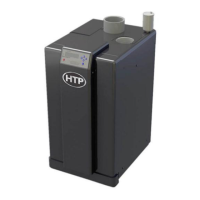LP-387 Rev. 011 Rel. 005 Date 1.3.19
20
• Glycol in hydronic applications should include inhibitors that
prevent the glycol from attacking metallic system components.
Make certain that the system uid is checked for the correct
glycol concentration and inhibitor level.
• The glycol solution should be tested at least once a year or as
recommended by the glycol manufacturer.
• Anti-freeze solutions expand more than water. For example:
A 50% by volume solution expands 4.8% in volume for a
temperature increase from 32
o
F to 180
o
F, while water expands
3% over the same temperature rise. Allowances must be made
in system design for expansion.
• A 30% mixture of glycol will result in a BTU output loss of 15%
with a 5% increase in head against the system circulator.
• A 50% mixture of glycol will result in a BTU output loss of 30%
with a 50% increase in head against the system circulator.
It is highly recommended that you carefully follow the glycol
manufacturer’s recommended concentrations, expansion
requirements, and maintenance recommendations (pH additive
breakdown, inhibitor reduction, etc.) You must carefully calculate
the additional friction loss in the system as well as the reduction in
heat transfer coecients.
L. Zoning with Zone Valves
1. When zoning with zone valves, connect the boiler to the system
as shown in Applications. The primary/secondary piping shown
ensures the boiler loop will have sucient ow. It also avoids
applying the high head of the boiler circulator to the zone valves.
2. Connect DHW (domestic hot water) piping to indirect storage
water heater as shown in Applications.
M. Zoning with Circulators
1. When using circulator zoning, connect the boiler to the system as
shown in Applications. NOTE: The boiler circulator cannot be used
for a zone. It must only supply the boiler loop.
2. Install a separate circulator for each zone.
3. Connect DHW (domestic hot water) piping to indirect storage
water heater as shown in Applications.
N. Multiple Boilers
1. Connect multiple boilers as shown in Applications.
2. All piping shown is reverse return to assure balanced ow
throughout the connected boilers.
3. Each connected boiler must have its own circulator pump to
assure adequate ow.
4. Connect DHW (domestic hot water) piping to indirect storage
water heater as shown in Applications.
5. The system ow (secondary loop) must be greater than the boiler’s
primary loop ow.

